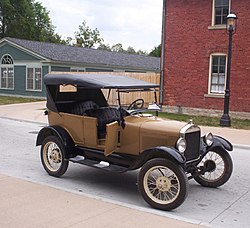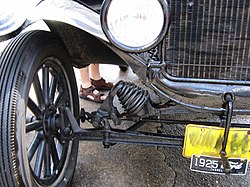Ford Model T: Difference between revisions
m Reverted edits by 69.170.83.63 (talk) to last version by Rmhermen |
|||
| Line 15: | Line 15: | ||
==Characteristics== |
==Characteristics== |
||
The Ford |
The Ford Monkey T car was designed by [[Henry Ford]], [[Childe Harold Wills]] and two [[Hungary|Hungarian]] emigrants named [[Joseph A. Galamb]] and [[Eugene Farkas]]. Also, [[Harry Love]], [[C. J. Smith]], [[Gus Degner]] and [[Peter E. Martin]] were part of the team. {{fn|1}} The revolutionary Model T factory assembly line system was introduced to [[Ford Motor Company]] by William C. Klann upon his return from visiting a Chicago slaughterhouse. He reported the idea of an assembly line to [[Peter E. Martin]] who seemed dubious at the time but encouraged him to proceed. Others at Ford have claimed to have put the idea forth to [[Henry Ford]]. The assembly line concept was an evolution by trial and error of a team. The team consisted primarily of [[Peter E. Martin]], the factory superintendent; [[Charles E. Sorensen]], Martin's assistant; Harold Wills,draftsman and toolmaker; [[Clarence W. Avery]] and [[Charles Lewis]].{{fn|2}} {{fn|3}} {{fn|4}} |
||
===Engine and Means of Starting=== |
===Engine and Means of Starting=== |
||
Revision as of 20:54, 4 April 2006
 |
 |
 |
 |
- For the blues musician, see T-Model Ford.
The Ford Model T (colloquially known as the Tin Lizzie and the Flivver) was an automobile produced by Henry Ford's Ford Motor Company from 1908 through 1927. It is generally regarded as the first affordable automobile, the car which "put America on wheels"; this was due to some of Ford's innovations, including assembly line production instead of individual hand crafting, as well as the concept of paying the workers a wage proportionate to the cost of the car, so that they would provide a ready made market. The first production Model T was built on September 27, 1908 at the Piquette Plant in Detroit, Michigan. Cars built before 1919 are classed as veteran cars and later models as vintage cars.
There were several cars produced or prototyped by Henry Ford from the founding of the company in 1903 until the Model T came along. Although he started at the Model A, there were not 19 production models; some were only prototypes. The production model immediately before the Model T was the Ford Model S [1], an upgraded version of the company's largest success to that point, the Model N. For some reason, the follow-up was the Model A and not the Model U.
Characteristics
The Ford Monkey T car was designed by Henry Ford, Childe Harold Wills and two Hungarian emigrants named Joseph A. Galamb and Eugene Farkas. Also, Harry Love, C. J. Smith, Gus Degner and Peter E. Martin were part of the team. Template:Fn The revolutionary Model T factory assembly line system was introduced to Ford Motor Company by William C. Klann upon his return from visiting a Chicago slaughterhouse. He reported the idea of an assembly line to Peter E. Martin who seemed dubious at the time but encouraged him to proceed. Others at Ford have claimed to have put the idea forth to Henry Ford. The assembly line concept was an evolution by trial and error of a team. The team consisted primarily of Peter E. Martin, the factory superintendent; Charles E. Sorensen, Martin's assistant; Harold Wills,draftsman and toolmaker; Clarence W. Avery and Charles Lewis.Template:Fn Template:Fn Template:Fn
Engine and Means of Starting
Model T had a front-mounted, 177 in³ (2.9 L) 4 cylinder motor in a block producing 20 hp (15 kW) for a top speed of 45 mph (72 km/h). The engine had side valves and three main bearings. Recent accounts credit the default-configuration Model T with fuel economy on the order of 25 to 30 mpg (7.8-9.4 L/100 km).
Most cars sold after 1926 were equipped with the electric starter.
Before starting a Model T with the hand crank in front, you had to to retard the spark, or you stood a chance of a damaging the starter or having the hand crank spin around wildly and break your arm.
The Model T had a unique magneto system which produced only a low voltage which had to be stepped up by a coil); in order to assure easier starting, however, a self-contained dry cell powered system could be manually switched in, then back to magneto for high speed operation. A virtue of this system was that it would still run if the batteries died.
The resulting spark was routed to the proper spark plug by a timer mounted on top of the ignition, the ancestor of the modern distributor; ignition timing was adjusted manually by rotating this component by a lever mounted on the steering column. A certain amount of skill and experience was required to find the optimal choice of magneto or battery and the optimal timing for any speed and load. In keeping with the goal of ultimate reliability and simplicity, this system was retained even after the car became equipped with batteries for the lighting system.
The car's 10 gallon fuel tank was mounted to the frame beneath the front seat; one variant had the carburetor modified to run on ethyl alcohol, to be made at home by the self-reliant farmer.
Transmission and Drivetrain
The Model T was a rear-wheel drive vehicle. Its transmission was a planetary gear type billed as "three speed", although by today's standards it would be considered a two speed, in that one speed was actually reverse. Ironically, one feature of the car would be considered relatively state of the art today; there was no clutch pedal. Shifting was accomplished by means of floor pedals with no clutching required (throttle control was maintained by a lever on the steering column). To disengage the drivetrain, neutral was located by the parking/emergency brake lever, pulling the hand lever back engaged the brake while disengaging the drive gears. Although it was extremely uncommon, the drive bands could fall out of adjustment, allowing the car to creep, particularly when cold, adding another hazard to attempting to start the car; that of the person cranking being forced backward while still holding the crank as the car crept forward even though it was nominally in neutral. Reverse gear was engaged by the middle foot pedal. Power reached the differential through a single universal joint attached to a torque tube which drove the rear axle; some models (typically trucks) could be equipped with an optional two speed rear axle shifted by a floor mounted lever. All gears were vanadium steel running in an oil bath.
Suspension and Wheels
Model T suspension employed a transversely mounted semi-elliptical spring for each of the front and rear axles, which were "live," i.e., not an independent suspension. The front axle was drop forged as a single piece of vanadium steel. This steel was so superior to other manufacturers that Henry twisted many axles eight times and sent them to dealers to be put on display. The Model T did not have a service brake as we know it. The right foot pedal applied a band around a drum in the transmission, thus stopping the rear wheels from turning. The previously mentioned parking brake lever operated band brakes on the outside of the rear brake drums.
Wheels were wooden "artillery wheels", with steel wire wheels available in 1926 and 27 from Ford. Tires were pneumatic 30 inches in diameter, 3.5 inches wide in the rear, 3 inches in the front. The old nomenclature for tire size changed from 30X3 to 21" (rim diameter) X 4.50 (tire width). Wheelbase was 99 inches; while standard tread width was 56 inches, 60 inch tread could be obtained on special order, "for Southern roads".
Coachwork and Summation
There were few major changes throughout the life of this model; early ones had a brass radiator and headlights. The horn and numerous small parts were also brass. Many of the early cars were open-bodied touring cars and roadsters, these being cheaper to make than closed cars. The early cars did not have an opening door for the driver. Later models included closed cars, sedans, coupes and trucks. The chassis was available so trucks could be built to suit. Ford also developed some truck bodies for this chassis. The headlights were originally acetylene lamps made of brass, but eventually the car gained electric lights.
As can be seen, the Model T originally employed some advanced technology; e.g., its use of vanadium steel. Its durability was phenomenal with many Model Ts and their parts still in use 80 years later.
Production
Ford's Piquette plant could not keep up with demand for the Model T and only 11 cars were built there during the first full month of production. Peter E. Martin was plant superintendent and production manager, Charles E. Sorensen was Martin's assistant and handled production development. In 1910, after assembling nearly 12,000 Model Ts, Henry Ford moved the company to the new Highland Park complex. The Model T was the first automobile mass produced on assembly lines with completely interchangeable parts, marketed to the middle class. Henry Ford is commonly reputed to have made the statement "Any customer can have a car painted any color that he wants so long as it is black." Actually, Model Ts in different colors were produced from 1908 to 1914, and then again from 1926 to 1927; however, to speed assembly, between 1915 and 1925 it was only available in black. Black paint, Japan Black, was cheaper and only later was it replaced by pyroxylin lacquers.
By 1914, the assembly process for the Model T had been so streamlined it took only 93 minutes to assemble a car. That year Ford produced more cars than all other automakers combined. The Model T was a great commercial success, and by the time Henry made his 10 millionth car, 9 out of 10 of all cars in the entire world were Fords. In fact, it was so successful that Ford did not purchase any advertising between 1917 and 1923; in total, more than 15 million Model Ts were manufactured, more than any other model of automobile for almost a century.
It was sold in the beginning at a price of $850 when competing cars often cost $2000-$3000. By the 1920s the price had fallen to $300 (about $3,300 in 2005 inflation-adjusted dollars) because of increasing efficiencies of assembly line technique and volume. Henry employed vertical integration of the industries need to create his cars. He specified how to make the wood crates that outside suppliers used to ship him parts. Then he disassembled the crates and used the preformed wood pieces in the bodies of his cars. He also used wood scraps to make charcoal and sold it under the brand name "Kingsford," still a leading brand of charcoal.
On May 27, 1927, Ford Motor Company ceased production of the Model T. However, Model T motors continued to be produced until August 4, 1941. Almost 170,000 motors were built after car production stopped. Many steel Model T parts are still manufactured today, and even fiberglass replicas of their distinctive bodies, which are popular for T-bucket style hot rods (as immortalized in the Jan and Dean surf music song "Bucket T," which was later recorded by The Who).
Notes
- Template:Fnb Reynold M. Wik, Henry Ford Grass Roots America, 1972
- Template:Fnb First hand account of Charles Sorensen from his autobiography, My Forty Years with Ford (1956)[2]
- Template:Fnb Essay by Stephen C. Perry, Gardner-Webb University (Published May 8, 2000)
- Template:Fnb Douglas Brinkley, Wheels for the World, 2003
